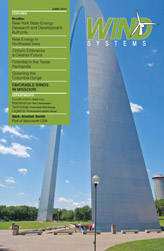Tell us a little about the port’s history and capabilities.
The Port of Vancouver was incorporated in 1912, so next year marks our hundredth year in operation. Vancouver was the third port established by the State of Washington, with the Port of Seattle first and Grays Harbor second. The reason the state purchased this land was to ensure fair market access to the waterfront by avoiding monopolization by other transportation service companies, like the railways. But the railroad systems now play a critical role in helping define the territory we cover. We are serviced by both BNSF Railroad Company and Union Pacific Railroad, with direct access to main lines that run from British Columbia to San Diego and eastward as far as Houston, Chicago, and beyond.
We can service Washington, Oregon, Montana, Idaho, the Dakotas, Illinois, Ohio, and Canada. Before we began investing in our wind-specific capabilities we assessed the market, which indicated that the five areas poised for growth in the United States are the Pacific Northwest, the Midwest, the Southwest, California, and Texas. We are well positioned to ship to three of those areas. In addition, the Port of Vancouver is located 104 miles inland at the end of a navigation channel for oceangoing vessels on the Columbia River, where the water is 43 feet deep. It really helps with overland shipping costs to be that far inland by water. Finally, we’re only two miles from the major interstate system, leading in all directions, and we’ve worked closely with engineers designing a new Interstate 5 bridge to include ramp and interchange designs that will accommodate oversized loads.
What are some of the wind-specific capabilities you mention?
When we decided to focus on the wind industry back around 1999 we put a great deal of thought into its projected growth, and how we could grow along with it. Just to give you an example, nacelles were only around 19 metric tons apiece at that time, and now they weigh as much as 95 metric tons. We invested in two Liebherr 500S mobile harbor cranes. These do away with the need to turn a vessel during discharge, creating even greater assurance that delays and expensive standby charges for longshoremen are avoided. The cranes are extremely mobile and move from dockside to staging or storage with ease. They are able to lift heavy nacelles from the offshore side of a vessel, saving time and added expense. For even larger loads, such as long tower sections, the cranes can be used in tandem. We are the only port in the Pacific Northwest with two heavy lift cranes, with crane operators that have received specialized oversize and heavy lift training on the Liebherr cranes.
We have also purchased additional land specifically for our wind operations. Wind energy imports require significant land for secure storage and staging. Components cannot be stacked on top of each other as is done with containers. The heavy equipment that lifts and repositions wind cargo also requires space, as do the specialized trucks that haul these huge pieces to storage and staging areas. We recently developed our new Terminal 5, which includes a dual BNSF and UP rail service loop track capable of handling unit trains of wind energy with the ability to load as many as 33 cars at a time. We expect to increase our wind laydown space at Terminal 5 from 30 to 70 acres within the next few months, and it will ultimately provide 100 acres of storage space at full build out, which is enough for 700 towers on the ground at one time. These investments will speed up loading, ultimately decreasing costs for customers.
Many wind manufacturers based overseas are building facilities in the States, but what else do you offer those still shipping components from Asia?
Three of the top wind manufacturers are located in China, which wasn’t the case only a few years ago, and while we’re a natural choice for anyone shipping to the Pacific Northwest and surrounding regions, we can also help them save a great deal when reaching wind-rich states in the Midwest. To ship from China straight to Gulf ports or Texas can be up to a 30-day trip. The distinct pricing advantage of bringing a project through the Pacific Northwest is a reduction in voyage time. It only takes about 15 days to reach Vancouver, which slashes transportation costs — including the ship and the fuel to run it—basically in half. One thing we learned when we were researching the wind industry is that you can’t do anything halfway. You’ve got to make the investments, provide the equipment, and streamline the delivery process to get the business. And that’s exactly the commitment we’ve made here at the Port of Vancouver USA.
To learn more: Call (360) 693-3611, e-mail info@portvanusa.com, or go online to www.portofvancouverusa.com.








































